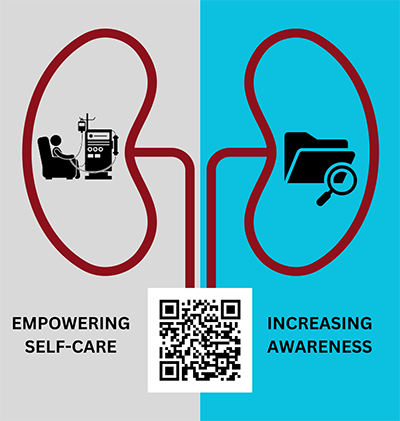Spotlight 2024
IMPROVING PATIENT SAFETY
Define the scope of vascular access blood loss in hemodialysis.
During hemodialysis treatments, dislodgement of the venous needle or catheter access-bloodline separation (ABLS) can lead to potentially catastrophic consequences if not immediately detected and the blood pump (dialysis machine) is stopped. When dialysis machines are pumping blood in and out of the patient at 300-400 ml/min, and even as high as 500 ml/min, if the venous access disconnects, blood is pumped into the environment instead of returning to the patient’s bloodstream. Life-threatening blood loss can occur in a matter of minutes.
The only protection afforded by dialysis machine is an internal venous pressure sensor and alarm intended to recognize a change in venous pressure and turn off the blood pump. However, the venous pressure alarm is notoriously unreliable detecting the small pressure changes associated with VND/ABLS. As a result, it may not trigger or there might be a significant delay.
Historically, VND has been characterized as a rare event in hemodialysis. But the true magnitude of the complication is unknown due to the lack of mandatory reporting. Informal surveys of dialysis professionals reveal incidences of VND are severely underreported.
Understand the current safety and quality initiatives to mitigate possible access blood loss in hemodialysis.
Professional Dialysis Nurse organizations in the Europe and the United States published Practice Recommendations for nurses and patients that educate, increase awareness and identify steps to mitigate the risk of VND and ABLS:
Education and awareness of multiple risk factors associated with VND and ABLS (it only takes one for VND to occur).
- Altered mental states (confused, restless, cognitive impairment)
- Treatment complications such as hypotension, muscle cramps; diaphoresis
- Noncompliant patients who refuse to keep their access and bloodlines uncovered
- Difficult cannulation
- Improper taping and bloodline securement
- Inadequate staffing and/or observation
- Unsupervised dialysis at home alone, or while sleeping.
- Mitigation of the patient’s individual risk factors
- Cannulation preparation
- Taping techniques
- Needle repositioning/Troubleshooting.
- Securing bloodlines
Hemodialysis Machine Safety for VND/ABLS
The Redsense blood loss detection system (“Redsense alarm”) is FDA-cleared and compliant with CE Mark and the new European Union Medical Device Regulations (EU MDR). The Redsense alarm continuously monitors and detect blood loss from the venous needle access or venous catheter bloodline connection. It functions independently of the dialysis machine so it can be used with any brand machine. Utilizing fiber optic technology, light is transmitted from the alarm unit, through the fiber optic extension, and into either a venous needle sensor patch or catheter sensor patch. The venous needle sensor is placed directly over the venous needle access, and catheter sensors are positioned at the catheter-bloodline connection. If blood loss is detected by the sensor, audio and visual alarms are immediately triggered to alert the caregiver or patient.
Showcase Redsense iterative design and usability of vascular access clamp device.
A companion device to the Redsense alarm prevents blood loss during a treatment if the Redsense alarm detects blood loss from VND or ABLS. Utilizing wireless technology, the Clamp occludes the bloodline, effectively stopping blood from escaping into the bed, chair, or floor. A dongle connected to the back of the Redsense alarm communicates wirelessly to the Clamp that is mounted on the bloodline close to the machine. If the Redsense alarm detects blood loss from VND or ABLS, the dongle sends a message to the clamp and the clamp’s motor engages to occlude the bloodline.

 Redsense has invited high-profile hemodialysis physicians Dr. Christopher Chan from UHN Toronto, Canada, and Dr. Joachim Beige from KfH Kuratorium Leipzig, Germany, to present and lead discussion at the industry spotlight session titled “An examination of adverse vascular access bleeding events: solving the unmet gap”. The session will be held on Friday May 24 at 14:50 – 15:10 CEST on “The Square” Spotlight Stage in the Exhibition area.
Redsense has invited high-profile hemodialysis physicians Dr. Christopher Chan from UHN Toronto, Canada, and Dr. Joachim Beige from KfH Kuratorium Leipzig, Germany, to present and lead discussion at the industry spotlight session titled “An examination of adverse vascular access bleeding events: solving the unmet gap”. The session will be held on Friday May 24 at 14:50 – 15:10 CEST on “The Square” Spotlight Stage in the Exhibition area. Christopher Chan, MD is a Nephrologist at the Toronto General University Health Network Hospital, Toronto, Canada where he is the Divisional Director of Nephrology and Professor of Medicine and holds the R Fraser Elliott Chair in Home Dialysis. Dr. Chan has dedicated his career to advancing home hemodialysis dialysis (HHD) and its numerous benefits. He has written several authoritative textbooks and numerous peer-reviewed articles related to home hemodialysis, and improved patient safety.
Christopher Chan, MD is a Nephrologist at the Toronto General University Health Network Hospital, Toronto, Canada where he is the Divisional Director of Nephrology and Professor of Medicine and holds the R Fraser Elliott Chair in Home Dialysis. Dr. Chan has dedicated his career to advancing home hemodialysis dialysis (HHD) and its numerous benefits. He has written several authoritative textbooks and numerous peer-reviewed articles related to home hemodialysis, and improved patient safety. Joachim Beige, MD is a Nephrologist who specializes in Renal Medicine Disease and Hypertension at Renal Centers Leipzig and Finsterwalde, Leipzig, Saxony, Germany where is the Medical Director and chief physician. Dr. Beige also serves as an Adjunct Professor at The Martin-Luther-University Halle-Wittenberg, Halle, Germany, and is the Principal Investigator in the Division of Nephrology at Klinikum St. Georg Hospital, Leipzig, Germany. Dr. Beige’s research interests are dedicated to nephrology-related diseases and comorbid conditions.
Joachim Beige, MD is a Nephrologist who specializes in Renal Medicine Disease and Hypertension at Renal Centers Leipzig and Finsterwalde, Leipzig, Saxony, Germany where is the Medical Director and chief physician. Dr. Beige also serves as an Adjunct Professor at The Martin-Luther-University Halle-Wittenberg, Halle, Germany, and is the Principal Investigator in the Division of Nephrology at Klinikum St. Georg Hospital, Leipzig, Germany. Dr. Beige’s research interests are dedicated to nephrology-related diseases and comorbid conditions.